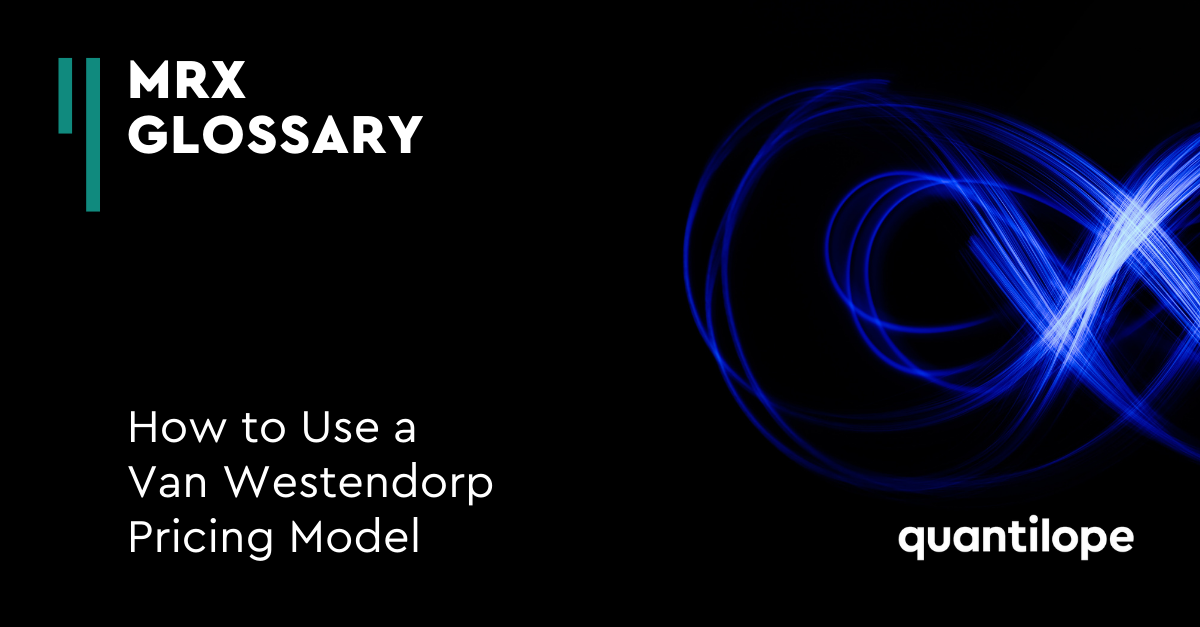In this blog post, learn how to leverage an automated Van Westendorp Pricing Model to inform your company's pricing strategy.
Table of Contents:
- What is a Van Westendorp Price Sensitivity Meter analysis?
- When should I use a Van Westendorp Price Sensitivity Meter analysis?
- How does the Van Westendrop pricing model work?
- How to use the Price Sensitivity Meter model to find an optimal price
- Limitations of Van Westendorp Price Sensitivity Meter
- Leverage Van Westendorp Price Sensitivity Meter (PSM) with quantilope
- How can quantilope help?
What is a Van Westendorp Price Sensitivity Meter analysis?
Van Westendorp (also known as Van Westendorp Price Sensitivity Meter) is one of the most established methodologies in the market research industry, first introduced in 1976 by the Dutch economist Peter van Westendorp. The method highlights a range of acceptable prices for a product or service and ultimately identifies an Optimal Price Point (OPP) - more on this below.
Van Westendorp works by asking respondents to give their reactions to a number of specific price points. Their reactions indicate how likely they are to make a purchase depending on the price.
Back to Table of Contents
When should I use a Van Westendorp Price Sensitivity Meter analysis?
Van Westendorp Price Sensitivity Meter is an ideal pricing method to use when you have a new product or service and you want to research where it should sit price-wise in the market.
Say for example you have a new bread product that you'd like to introduce. You already have an extensive variety of bakery products within your brand, and beyond this, your competitors have impressive product lines too. There are a lot of factors that consumers will take into account before buying from the category, including perceptions of brands, marketing messages, dietary needs, product use, and packaging. Their views on price will be driven by all of these factors and more (which you should also determine as part of your research program).
The aim is to find the right price that reflects how consumers perceive your product's brand credentials, quality, and relevance, but also how it will sit in relation to similar products on the market. Negative price perceptions can impact success; price a product or service too cheap and it will project an image of low quality. Meanwhile, pricing something too expensive could lead to competitor products winning over market share. Your Optimal Price Point (OPP) will be the price at which the highest number of people consider your product/service a good value for its quality and will therefore buy it.
Back to Table of Contents
How does the Van Westendorp pricing model work?
Van Westendorp's Price Sensitivity Meter (PSM) is a great methodology to determine the "sweet spot" for pricing your product or service. It's all about understanding how customers perceive your price and finding the range where they feel it's both fair and attractive. Below are the questions you'll need to ask your target audience to find what that price range will be.
Van Westendorp questions to ask:
A typical Van Westendorp Price Sensitivity Meter consists of four key pricing questions:
- What price is so expensive that you would not purchase the product/service?
- What price is so low that you would question the quality of the product/service?
- What price is starting to get expensive but you would still purchase the product/service?
- What price is considered a bargain/great buy for the product/service?
How to use the Van Westendorp model to find an optimal price
Once respondents have been surveyed, the Van Westendorp Price Sensitivity Meter plots their reactions as data points on a line graph. To find the optimal price point (OPP), researchers need to define the boundaries of an acceptable price range: the Point of Marginal Cheapness (PMC) and the Point of Marginal Expensiveness (PME).
The PMC is at the lower bound of an acceptable price range, where 'too cheap' and 'expensive' intersect on the Van Westendorp's graph. Going lower than this price would adversely affect perceptions of product quality. The PME is where 'too expensive' and 'cheap' intersect, and is the upper bound of an acceptable price range. Going beyond this price point would lose many customers who find the price too high.
The Indifference Price Point (IPP) is where 'cheap' and 'expensive' intersect within the Van Westendorp analysis. This is the price point at which the number of respondents who feel the price is cheap is equal to those who feel it is expensive. Although the IPP isn't advised as the price to set for your product/service, it can help in guiding pricing if the Optimal Price Point (explained below) is too low for your business needs.
The Optimal Price Point (OPP) occurs at the intersection of the 'too cheap' and 'too expensive' lines in the Van Westendorp analysis. This is the point at which an equal number of respondents describe the price as too high or too low and is optimal because it would minimize the number of people who would be dissatisfied with the price.
Back to Table of Contents
Limitations of a Van Westendorp Price Sensitivity Meter
It's worth bearing in mind that the range of acceptable prices in this type of pricing analysis is entirely from a consumer's point of view. While helpful to know what consumers will be prepared to pay, many researchers pair this method with another pricing methodology, like a Conjoint analysis, to balance consumer preferences with business costs and profit margin targets. Together, these insights fuel a well-informed decision on price.
Back to Table of Contents
Leverage Van Westendorp Price Sensitivity Meter (PSM) with quantilope
quantilope's automated Van Westendorp/Price Sensitivity Meter (PSM) provides researchers and insights leaders with sophisticated pricing information to make informed business decisions.
The following video provides a short demonstration on how to set up this pricing research method on quantilope's platform and how to quickly analyze the various chart outputs:


How can quantilope help?
quantilope users can leverage the Van Westendorp/Price Sensitivity Meter method to quickly and easily understand consumer perceptions of price points and guide pricing decisions.
With quantilope, the necessary four questions needed to run a Van Westendorp analysis are automatically added to your questionnaire by selecting the method from quantilope's method library. In doing so, you remove any guesswork in phrasing questions the right way or remembering to ask the right questions.
Once the method is added to the survey, pricing research is made simple thanks to quantilope's built-in automated analysis tools, offering a variety of chart options so that you can clearly see metrics such as: where the range of acceptable prices lies, the profile of your potential customers, and more. All these different chart types are generated with the click of a mouse, simply by selecting each type from the analysis dropdown menu.
Check out a brief Van Westendorp/Price Sensitivity Meter demo video here to see how straightforward it is to create a Van Westendorp analysis, and explore quantilope's retail study to see how a Price Sensitivity Meter was used to find the optimal price for next day shipping.
To learn more about quantilope's Van Westendorp/Price Sensitivity Meter pricing tool, get in touch below:




.png)